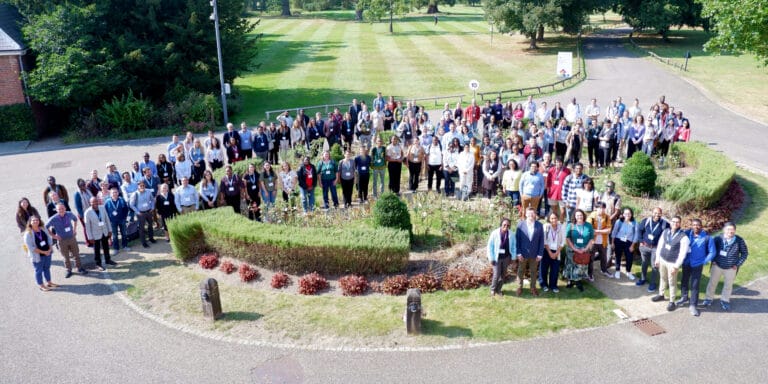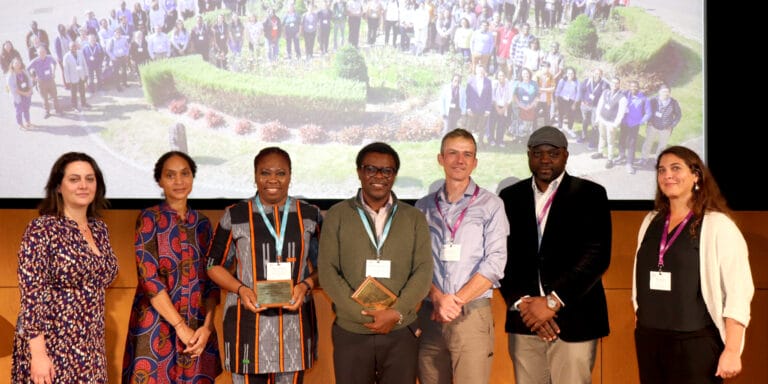
Note that the selection of papers presented here is subjective; Dominic published hundreds of scientific papers over his distinguished career, so any choice of 10 papers will necessarily miss out many fascinating studies!
Jump to topic:
Genetics of malaria disease susceptibility
Plasmodium falciparum genomic diversity and antimalarial resistance
Plasmodium vivax genomic diversity
Anopheles genomic diversity and insecticide resistance
Founding MalariaGEN
MalariaGEN. 2008. Nature. A global network for investigating the genomic epidemiology of malaria. https://www.nature.com/articles/nature07632
Describing the original MalariaGEN network and its founding policies on data sharing, intellectual property, and publications – even 15 years after publication it all still holds true. With partners across 21 countries, 4 consortial projects with co-developed scientific questions brought together co-investigator led studies. The resulting high quality, well curated global resource led to multiple publications from MalariaGEN investigators and external data users. For me this is the seminal manuscript in the MalariaGEN story, the principles laid out here echo through parasite and mosquito programmes that followed.
— Dr Vikki Simpson
Genetics of malaria disease susceptibility
MalariaGEN. 2019. Nat Comms. Insights into malaria susceptibility using genome-wide data on 17,000 individuals from Africa, Asia and Oceania. https://www.nature.com/articles/s41467-019-13480-z
This study reports the final results of a flagship MalariaGEN collaborative project, investigating the human genetics of susceptibility to, and protection against, severe malaria. Dominic was fascinated by this question since working as a paediatrician in The Gambia in the 1980s: why do some children become very sick with malaria and others don’t? This Genome Wide Association Study (GWAS) with over 17,000 severe malaria cases settled the long held view of sickle cell trait offering strong protection against severe malaria, and identified four other regions in the human genome associated with malaria severity, including the ABO blood group locus.
As a MalariaGEN Data Fellow who helped to curate some of this data, the findings of this analysis validated our work as Data Fellows and acted as an impetus for me to delve more deeply into malaria susceptibility studies. On a personal level, the observed increased susceptibility of AB blood group carriers to severe malaria brought to the fore by own experiences of repeated admissions and near misses of death with malaria as a child growing up in northern Ghana. After all, I am AB positive myself.
— Dr Lucas Amenga-Etego
Leffler, E. … Kwiatkowski, D.P. 2017. Science. Resistance to malaria through structural variation of red blood cell invasion receptors. https://www.science.org/doi/abs/10.1126/science.aam6393
This paper follows up on a region of the human genome that previous work led by Dominic had identified as being associated with strong protection against severe malaria. The region was difficult to characterise due to high levels of genetic diversity in Africa that is underrepresented in genetic databases, and the fact that several large genomic regions are duplicated and arranged in series. The authors improved the representation of genetic data from sub-Saharan Africa by whole genome sequencing 765 people from The Gambia, Burkina Faso, Cameroon, and Tanzania. They focused on complex forms of genetic variation in a cluster of genes called glycophorins expressed on the red blood cell surface.
They discovered that the signal of protection against severe malaria originated from a gene rearrangement that created a hybrid glycophorin gene, called DUP4. Subsequent work went on to show that the mechanism of protection against malaria appears to involve increasing the rigidity of the red blood cell membrane. This was a major scientific discovery – one of the strongest genetic associations with malaria protection known.
— Dr William Hamilton
Plasmodium falciparum genomic diversity and antimalarial resistance
Manske, M., Miotto, O. … Kwiatkowski, D.P. 2012. Nature. Analysis of Plasmodium falciparum diversity in natural infections by deep sequencing. https://www.nature.com/articles/nature11174
This landmark publication was the first global analysis of Plasmodium falciparum diversity from whole-genome sequencing of clinical samples. It included 226 parasite samples from Africa, Southeast Asia and Oceania, and showed clear geographical structure, and continental differences in allele spectra and linkage. It relied on several methodological breakthroughs: leukocyte filtering methods minimized human DNA “contamination” in blood samples, reducing cost; frequency-based filtering of discovered variants removed low-confidence SNPs, reducing errors; and a new metric of within-sample diversity (FWS) was defined to characterize polyclonal infections in terms of population diversity. This publication launched the MalariaGEN Community Project, which has since powered dozens of studies.
— Professor Olivo Miotto
Miotto, O. … Kwiatkowski, D.P. 2013. Nat Gen. Multiple populations of artemisinin-resistant Plasmodium falciparum in Cambodia. https://pubmed.ncbi.nlm.nih.gov/23624527/
This article described three very distinct populations of artemisinin-resistant P. falciparum parasites in Cambodia, all located within a small geographical region. Through an analysis of fine-scale population structure, the study identified independent founder effects and recent expansions within these populations. The research provided a detailed characterization of these three resistant populations and surveyed a range of admixed samples, which consisted of recombinants with wild-type parasites. The discovery of sympatric but independent populations of resistant parasites underscored the critical importance of implementing robust surveillance strategies, as advocated by Dominic, to effectively prevent the spread and emergence of artemisinin-resistant malaria.
— Dr Jacob Almagro-Garcia
MalariaGEN. 2023. Wellcome Open Res. Pf7: an open dataset of Plasmodium falciparum genome variation in 20,000 worldwide samples. https://wellcomeopenresearch.org/articles/8-22
The latest MalariaGEN data resource contained more than 20,000 genomes from 33 countries. It is an important milestone for malaria genomics globally as it is the first time dried blood spot samples are included in the data resources, which was possible due to selective whole genome amplification. The paper presents global analysis of particularly relevant regions of the P. falciparum genome, including the vaccine target csp gene, the deletions associated with rapid diagnostic treatment failures and heterogeneities in the crt gene. Dominic proved the importance of global spatio-temporal sample collections to build our understanding of the parasite’s underlying genetic background and identify changes in patterns. His vision of the role of genomics and global resources on malaria control and elimination was very unique and I will forever remember the look in his eyes when talking about it.
— Dr Cristina Ariani
Amambua-Ngwa, A. 2019. Science. Major subpopulations of Plasmodium falciparum in sub-Saharan Africa. https://pubmed.ncbi.nlm.nih.gov/31439796/
Dominic supported the first major African-led study on the population structure of Plasmodium falciparum using whole genome sequencing. Africa is both the birthplace and the main home of malaria parasites, particularly P. falciparum, the deadliest of the five human malaria species. All of Africa is at risk; 95% of the 240 million malaria cases in 2022 were in sub-Saharan Africa. To further understand the parasite’s epidemiology across Africa, scientists working in the Plasmodium Diversity Network in Africa (PDNA) collaborated with MalariaGEN under Dominic’s leadership, to sequence over 2,300 P. falciparum isolates from malaria patients sampled in 15 African countries. PDNA is led by Professor Abdoulaye Djimde, with additional support provided by Dominic and MalariaGEN.
Key findings of the study include: 1) Infections in different regions were caused by six major subtypes of P. falciparum, distributed geographically into West, Central, Southcentral, East, Southeast and a very unique sub-group from Ethiopia; 2) P. falciparum may have first jumped into humans from non-human primates around the Congo basin; and 3) There had been recent exchange of genetic material between the geographic sub-groups, especially regions of the genome that encode resistance to antimalarial drugs. Thanks to Dominic’s mentorship and support, data analysis and writing was performed mostly in Africa by my team at the MRC Unit The Gambia. The data generated and analysed is openly available and has been used by many other malaria scientists across the world, fostering the spirit of data sharing pioneered and championed by Dominic through MalariaGEN.
— Professor Alfred Amambua-Ngwa
Plasmodium vivax genomic diversity
Pearson, R.D. … Kwiatkowski, D.P. 2016. Nat Gen. Genomic analysis of local variation and recent evolution in Plasmodium vivax. https://www.nature.com/articles/ng.3599
This article showed that it is possible to make epidemiologically relevant discoveries from large scale whole genome sequencing of Plasmodium vivax from patient blood samples. P. vivax poses technical challenges for genome sequencing that first had to be overcome, such as low levels of parasites in patient blood samples. The paper then investigated drug resistance mutations, including those due to copy number variations, by analysis of signatures of selection. This will be particularly important going forward for P. vivax, where unlike P. falciparum it is not possible to conduct experiments on parasites grown in long-term culture. Another key finding was that whole genome sequence data can differentiate mixed-genotype infections between those that are from the same or from separate mosquito bites, the theory of which was a key driver of Dominic’s research into malaria transmission patterns. The MalariaGEN P. vivax Genome Variation Project remains the largest open-access repository of P. vivax whole genomes worldwide, with almost 2,000 genomes in the latest data release (v4, Feb 2023).
— Dr Richard Pearson
Anopheles genomic diversity and insecticide resistance
The Anopheles gambiae 1000 Genomes Consortium. 2017. Nature. Genetic diversity of the African malaria vector Anopheles gambiae. https://www.nature.com/articles/nature24995
A selection of vector biologists working in Africa explored what mosquito collections or DNA extracts they had available to create a baseline understanding of genetic structure in the continent’s worst malaria vector species. Inside the project, we politely referred to this as “freezer trawling”. I remember the early meetings in the late 2000s where many of us shared perplexity as to what value this activity would bring when there were no phenotypes connected to these mosquitoes we were about to sequence at some considerable cost. It was of course clear to Dominic from the beginning and it turned out to become clear to the rest of us as time marched on and the data began to flow.
We discovered unprecedented levels of genetic variation (a SNP every few bases!?) and showed that what was thought to be two mutational events leading to major insecticide resistance sweeps was actually repeated convergent mutations on distinct genetic backgrounds. Additionally, the paper drew important attention to the challenge for gene drive presented by the extreme levels of genetic variation found in these major vector species. In short, this paper was instrumental in revealing the value of population genomic sequencing for important disease vectors – an activity that continues to attract researchers and funding today, in no small part due to Dominic’s vision in the late 2000s that sequencing mosquitoes at scale would be a sensible thing to do.
— Dr Mara Lawniczak
Host-parasite interaction
Band, G. … Kwiatkowski, D.P. 2022. Nature. Malaria protection due to sickle haemoglobin depends on parasite genotype. https://www.nature.com/articles/s41586-021-04288-3
This paper searched for associations between human and malaria parasite genetic variation to investigate how host and parasite genomes interact with each other and influence disease severity. Three regions of the parasite genome were discovered to be associated with sickle haemoglobin – the strongest known genetic determinant of protection against severe malaria. The implication is that some parasites have become ‘specialised’ at infecting people with sickle cell. The study is a clear illustration of the fact that malaria parasites, the human host and the insect vector are entwined in an evolutionary arms race – a concept that Dominic explored extensively throughout his scientific career.
— Dr William Hamilton



